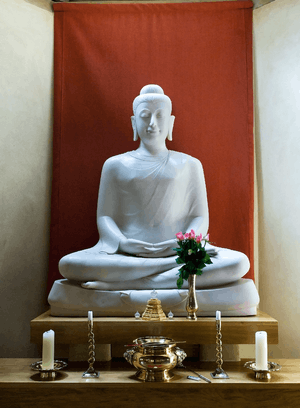Buddhism in England
Buddhism is quite a recent religion to arrive in England. Despite this, 238,626 people in England declared themselves to be Buddhist at the 2011 Census and 34% of them lived in London.[1]
| Year | Percent | Increase |
|---|---|---|
| 2001 | 0.3% | - |
| 2011 | 0.5% | +0.20% |
| Part of a series on |
| Western Buddhism |
|---|
.jpeg) |
|
|
|
|
|
|
|
Exchange
|
|
General Buddhism
|
| Part of a series on |
| Buddhism |
|---|
 |
|
|
| Historical Population | ||
|---|---|---|
| Year | Pop. | ±% |
| 2001 | 139,046 | — |
| 2011 | 238,626 | +71.6% |
| Religious Affiliation was not recorded prior to 2001. | ||
History

Theravada influences grew in England during the early 20th century. A few of the significant events were the foundation of London’s Buddhist Society in 1924 and the Theravada London Buddhist Vihara in Chiswick in 1926. Anagarika Dharmapala (1864-1933), the founder of the Mahā Bodhi Society in 1891, was instrumental in presenting Buddhism as a living monastic tradition to the UK.[2] The return of Ananda Metteyya to England on 23 April 1908 after travels in Ceylon and monk ordination in Burma was another significant milestone in the legacy of British Buddhism. A slow trickle from England travelled to Asia to take monastic ordination, mainly as Theravadin monks. Kapilavaddho Bhikkhu introduced the Dhammakaya tradition to the UK in 1954 in this way and founded the English Sangha Trust in 1955. A few Asian monks came to live in England.
In 1967, Englishman Sangharakshita (1925-2018), who had spent time in the east as a Theravadin monk, founded the Friends of the Western Buddhist Order (later renamed Triratna Buddhist Community).
The Manjushri Institute, a large Buddhist college at Conishead Priory in Cumbria, was founded under the guidance of the Tibetan Gelugpa monk Thubten Yeshe in 1976.[3] In 1991, it was subsumed by the New Kadampa Tradition, a new religious movement founded by another monk, Kelsang Gyatso.[4][5]
A Theravada monastery consisting mainly of Westerners following the Thai Forest Tradition of Ajahn Chah was established at Chithurst Buddhist Monastery in Sussex, and has established branches elsewhere in the country. A lay meditation tradition of Thai origin is represented by the Samatha Trust, with its headquarters cum retreat centre in Wales. Sōtō Zen has a priory at Throssel Hole Buddhist Abbey in Northumberland.
There are now many Buddhist groups in England. To name a few from the Tibetan Tradition there are Sanghas of: Rigpa,[6] Karma Kagyu,[7] Dechen,[8] Diamond Way Buddhism[9] and Aro gTér[10]
The Dalai Lama visited Aldershot in both 2010 and 2015, on the latter occasion formally opening the Aldershot Buddhist Centre.[11]
Demographics
In 2001 Buddhism constituted 0.3% of the population of England,[12] which increased to 0.5% in 2011 census.[13] According to the 2011 census, there are 238,626 Buddhists in England.
The district with the highest proportion of Buddhists at the 2011 Census was Rushmoor in Hampshire, with 3.3% of respondents identifying as Buddhist: this is mainly due to the area's (specifically Aldershot's) historic ties with the Gurkha regiment.[14]
References
- "2011 Census: KS209EW Religion, local authorities in England and Wales". ons.gov.uk. Retrieved 15 December 2012.
- Mahinda Deegalle (ed.), Dharma to the UK: A Centennial Celebration of Buddhist Legacy. London: World Buddhist Foundation, 2008.
- Bluck (2006), p. 129
- Oliver, Paul (2012). New Religious Movements: A Guide for the Perplexed. A&C Black. pp. 84–88. ISBN 978-1-4411-2553-8.
- Kay, David N. (1997). "The New Kadampa Tradition and the Continuity of Tibetan Buddhism in Transition" (PDF). Journal of Contemporary Religion. Routledge. 12 (3): 277–293. doi:10.1080/13537909708580806.
- Rigpa
- Karma Kagyu
- Dechen
- Diamond Way Buddhism
- Aro gTér.
- "Archived copy". Archived from the original on 2015-08-04. Retrieved 2015-07-28.CS1 maint: archived copy as title (link)
- http://data.gov.uk/dataset/religion_2001_census
- http://www.ons.gov.uk/ons/publications/re-reference-tables.html?edition=tcm%3A77-286262
- https://www.bbc.co.uk/news/magazine-20692122
Sources
- Bluck, Robert (2006). British Buddhism: Teachings, Practice and Development. Routledge. ISBN 978-1-134-15817-1.